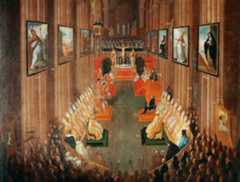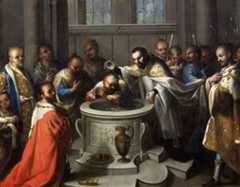Our editors will review what you’ve submitted and determine whether to revise the article.
- CORE - The implementation of the Counter-Reformation in Catalan-speaking lands (1563-1700): A successful process?
- Khan Academy - Introduction to the Protestant Reformation: The Counter-Reformation
- World History Encyclopedia - Counter-Reformation
- PBS - Counter-Reformation
- Durham Research Online - England and the Catholic Reformation: the Peripheries Strike Back
- Eternal Word Television Network - The Catholic Reformation
- Gresham College - EnglandÂ’s Catholic Reformation
- Colorado Community College System Pressbooks - PPSC HIS 1310 Western Civilization: Antiquity to 1650 - The Counter (Catholic) Reformation
- Humanities LibreTexts - The Catholic Reformation
Counter-Reformation
What was the Counter-Reformation of the Roman Catholic Church?
The Counter-Reformation largely grew as a response to the ProtestantReformation and was a movement of reform within theRoman Catholic Church. The Counter-Reformation served to solidifydoctrine that many Protestants were opposed to, such as the authority of thepope and the veneration ofsaints, and eliminated many of the abuses and problems that had initially inspired the Reformation, such as the sale ofindulgences for the remission ofsin.
How were the Jesuits important in the Counter-Reformation?
TheJesuits helped carry out two major objectives of the Counter-Reformation: Catholic education and missionary work. The Jesuits established numerous schools and universities throughout Europe, helping to maintain the relevance of the Catholic church in increasingly secular and Protestant societies. With thecolonization of the New World, Jesuits established missions throughout Latin America to win converts among the indigenous peoples. Jesuits were also among the first missionaries to East Asia of modern times, contributing to the spread of Catholicism around the globe.
Was the Counter-Reformation successful?
Yes and no. As evidenced by the more than half a billion Protestants around the world, the Counter-Reformation did not halt the spread ofProtestantism in Europe and beyond. However, the Counter-Reformation did much to reform many of the problems and extravagances thatMartin Luther originally objected to in hisNinety-five Theses. Various aspects of doctrine, ecclesiastical structures, new religious orders, and Catholic spirituality were clarified or refined, and Catholic piety was revived in many places. Additionally, Catholicism achieved a global reach through the many missionary endeavours that were initiated during the Counter-Reformation. These reforms and growth did much to maintain Catholicism as the dominant Christian tradition.
Counter-Reformation, in the history ofChristianity, theRoman Catholic efforts directed in the 16th and early 17th centuries both against the ProtestantReformation and toward internal renewal. The Roman Catholic Church responded to the Protestant challenge by purging itself of the abuses andambiguities that had opened the way to revolt and then embarked upon recovery of the schismatic branches of Western Christianity with mixed success. The Counter-Reformation took place during roughly the same period as the Protestant Reformation, actually (according to some sources) beginning shortly beforeMartin Luther’s act of nailing theNinety-five Theses to the door of Castle Church in 1517.
Council of Trent
Early calls for reform grew out ofcriticism of the worldly attitudes and policies of theRenaissance popes and many of the clergy, but there was little significant papal reaction to the Protestants or to demands for reform from within the Roman Catholic Church before mid-century. PopePaul III (reigned 1534–49) is considered to be the firstpope of the Counter-Reformation. It was he who in 1545convened theCouncil of Trent, which is hailed as the most important single event in the Counter-Reformation. The council, which met intermittently until 1563, responded emphatically to the issues at hand and enacted the formal Roman Catholic reply to the doctrinal challenges of the Protestant Reformation. It thus represents the official adjudication of many questions about which there had been continuingambiguity throughout theearly church and the Middle Ages. What emerged from the Council of Trent was a chastened but consolidatedchurch and papacy, the Roman Catholicism of modern history.
Its doctrinal teaching was a reaction against theLutheran emphasis on the role of faith and God’sgrace and against Protestant teaching on the number and nature of thesacraments. The “either/or” doctrines of the Protestant reformers—justification by faith alone, the authority of Scripture alone—were anathematized, in the name of a “both/and” doctrine of justification by both faith and works on the basis of the authority of both Scripture and tradition. The privileged standing of the LatinVulgate was reaffirmed against Protestant insistence upon the original Hebrew and Greek texts of Scripture.
No less important for the development of modern Roman Catholicism was the legislation of Trent aimed at reforming—and re-forming—the internal life anddiscipline of the church. Disciplinary reforms attacked the corruption of the clergy and affirmed the traditional practice in questions of clerical marriage. The council condemned such abuses aspluralism. There was an attempt to regulate the training of candidates for the priesthood. Indeed, two of its most far-reaching provisions were the requirement that everydiocese provide for the proper education of its future clergy in seminaries under churchauspices and the requirement that the clergy, and especially thebishops, give more attention to the task of preaching. Measures were taken against luxurious living on the part of the clergy, and the financial abuses that had been so flagrant in the church at all levels were brought under control. Strict rules requiring the residency of bishops in their dioceses were established, and the appointment of relatives to church office was forbidden. Prescriptions were given about pastoral care and the administration of the sacraments, and, in place of the liturgicalchaos that had prevailed, the council laid down specific prescriptions about the form of themass andliturgical music. Unlike earlier councils, the Council of Trent did not result in the diminution of papal authority.
- Also called:
- Catholic Reformation or Catholic Revival
- Date:
- c. 1501 -c. 1650
- Participants:
- Roman Catholicism
Outside of the Council, various theologians—especially theJesuitSt. Robert Bellarmine—attacked the doctrinal positions of the Protestant reformers, but there was no one to rival the theological andmoral engagement evident in the writings of Martin Luther or the eloquence and passion characteristic of the works ofJohn Calvin. New religious orders and other groups were founded to effect a religious renewal—e.g., the Theatines, theCapuchins, theUrsulines, and especially theJesuits. Later in the century,St. John of the Cross andSt. Teresa of Ávila promoted the reform of theCarmelite order and influenced the development of themystical tradition.St. Francis de Sales had a similar influence on the devotional life of the laity. The popes of the Counter-Reformation were largely men of sincereconviction andinitiative who skillfully employed diplomacy, persuasion, and force against heresy. During this period of reform and reaction, Roman Catholic theologians and leaders tended to emphasize the beliefs and devotional subjects that were under direct attack by the Protestants—e.g., the real presence ofChrist in theEucharist, theVirgin Mary, andSt. Peter.









